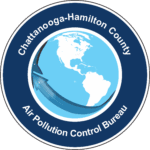Daily Air Quality Report
Today's Forecast
50
Good
Fine Particles
Past 24 Hours*
36
Good
Pollutant
Fine Particles
Pollutant
Ozone
Grass: Low (Poaceae)
Tree: Low (Elm)
Weed: Moderate (Mugwort, Urticaceae)
Cladosporium
Current Pollen and Air Quality Information
NOTE: POLLEN WIDGET UNAVAILABLE AT THIS TIME.
Pollen Sense is upgrading the data models and AI detector models over the next two weeks. Please note that the data reported may not reflect accurately during this system-wide update. Your patience is greatly appreciated. Better identification is on the horizon!
Details for the Last 24 Hours*
Tree: Low (Elm)
Weed: Moderate (Mugwort, Urticaceae)

Subscribe to Daily AQI Reports
Follow us:
*Pollen and mold spore counts are for the previous 24 hours. Pollen is collected at 8:15 a.m., Monday through Friday, and the report is updated by 9:00 a.m. The Bureau is not a participant in the American Academy of Allergy Asthma & Immunology’s National Allergy Bureau™ (NAB™). The pollen count is for the date listed on the home page of the website.
U.S. Environmental Protection Agency’s scale for rating air quality:
| Good 0-50 | PM2.5 24hr Avg.0-12.0 | 8-Hour Ozone Concentration 0-0.054 |
| Cautionary Statements None | ||
| Moderate 51-100 | PM2.5 24hr Avg. 12.1-35.4 | 8-Hour Ozone Concentration 0.055-0.070 |
| Cautionary Statements Unsusually sensitive people should consider reducing prolonged or heavy outdoor exertion. | ||
| Unhealthy for Sensitive Groups101-150 | PM2.5 24hr Avg. 35.5-55.4 | 8-Hour Ozone Concentration 0.071-0.085 |
| Cautionary Statements People with heart or lung disease, older adults, and children should reduce prolonged or heavy outdoor exertion. | ||
| Unhealthy 151-200 | PM2.5 24hr Avg. 55.5-150.4 | 8-Hour Ozone Concentration 0.086-0.105 |
| Cautionary Statements People with heart or lung disease, older adults, and children should avoid prolonged or heavy outdoor exertion. Everyone else should reduce prolonged or heavy outdoor exertion. | ||
| Very Unhealthy 201-300 | PM2.5 24hr Avg. 150.5-250.4 | 8-Hour Ozone Concentration 0.106-0.200 |
| Cautionary Statements People with heart or lung disease, older adults, and children should avoid all outdoor exertion. Everyone else should reduce prolonged or heavy outdoor exertion. | ||
| Hazardous 301-500 | PM2.5 24hr Avg. >250.5 | 8-Hour Ozone Concentration >0.200 |
| Cautionary Statements People with heart or lung disease, older adults, and children should remain indoors and keep activity levels low. Everyone else should avoid all physical activity outdoors. | ||
U.S. Environmental Protection Agency’s scale for rating air quality:
| Good 0-50 | PM2.5 24hr Avg.0-12.0 | 8-Hour Ozone Conentration 0-0.054 | Cautionary Statements None. |
| Moderate 51-100 | PM2.5 24hr Avg. 12.1-35.4 | 8-Hour Ozone Concentration 0.055-0.070 | Cautionary Statements Unsusually sensitive people should consider reducing prolonged or heavy outdoor exertion. |
| Unhealthy for Sensitive Groups101-150 | PM2.5 24hr Avg. 35.5-55.4 | 8-Hour Ozone Concentration 0.071-0.085 | Cautionary Statements People with heart or lung disease, older adults, and children should reduce prolonged or heavy outdoor exertion. |
| Unhealthy 151-200 | PM2.5 24hr Avg. 55.5-150.4 | 8-Hour Ozone Concentration 0.086-0.105 | Cautionary Statements People with heart or lung disease, older adults, and children should avoid prolonged or heavy outdoor exertion. Everyone else should reduce prolonged or heavy outdoor exertion. |
| Very Unhealthy 201-300 | PM2.5 24hr Avg. 150.5-250.4 | 8-Hour Ozone Concentration 0.106-0.200 | Cautionary Statements People with heart or lung disease, older adults, and children should avoid all outdoor exertion. Everyone else should reduce prolonged or heavy outdoor exertion. |
| Hazardous 301-500 | PM2.5 24hr Avg. >250.5 | 8-Hour Ozone Concentration >0.200 | Cautionary Statements People with heart or lung disease, older adults, and children should remain indoors and keep activity levels low. Everyone else should avoid all physical activity outdoors. |
The Bureau provides information about its monitoring activities in the daily Air Quality Report, which can also be accessed by phone at 423.643.5971.
This information includes:
- Air Quality Index – The Air Quality Index (AQI) was designed by the EPA to provided a standardized, national method of measuring air quality. It classifies air quality concentrations as good, moderate, unhealthy for sensitive groups, unhealthy, very unhealthy and hazardous, based on a scale of 0-500. More information is available in EPA’s Air Quality Index brochure.
In Hamilton County, Tennessee the daily air quality level is determined by either the ozone or particulate concentration, depending on which is higher on that day. Since the early 1980’s, most days have been in the good range.
- Forecast – The Tennessee Department of Environment and Conservation’s Air Pollution Control Department (TDEC) gathers information from monitors all over the state. This information is then used to predict air quality for the next 48 hours. The Daily Air Quality Report includes both an actual reading from the day before and a forecast for the next day, based on TDEC’s prediction.
- Burning Status – Burning is allowed in Hamilton County between October 1 and April 30 with the appropriate permits. The burning status is determined by the predicted daily air quality and Forestry’s burning safety determination. You can also find out the day’s burning status by calling the Information Line at 423.643.5971.
- Pollen and Mold Spore Counts – The Air Monitoring Department uses a pollen monitor to collect the pollen grains and mold spores in the air. The monitor runs for a 24 hour period, from 8:00 a.m. – 7:59 a.m. the following day. The particles are then put under a microscope to identify the types of pollen/mold, and count the number of each. These findings are reported on the daily Air Quality Report, and levels are indicated with a scale that indicates the severity of the pollutant. Pollen and mold spore counts are for the previous 24-hour period. We monitor pollen and mold spore levels from 8:00 a.m. on Sunday through 8 a.m. on Friday.

